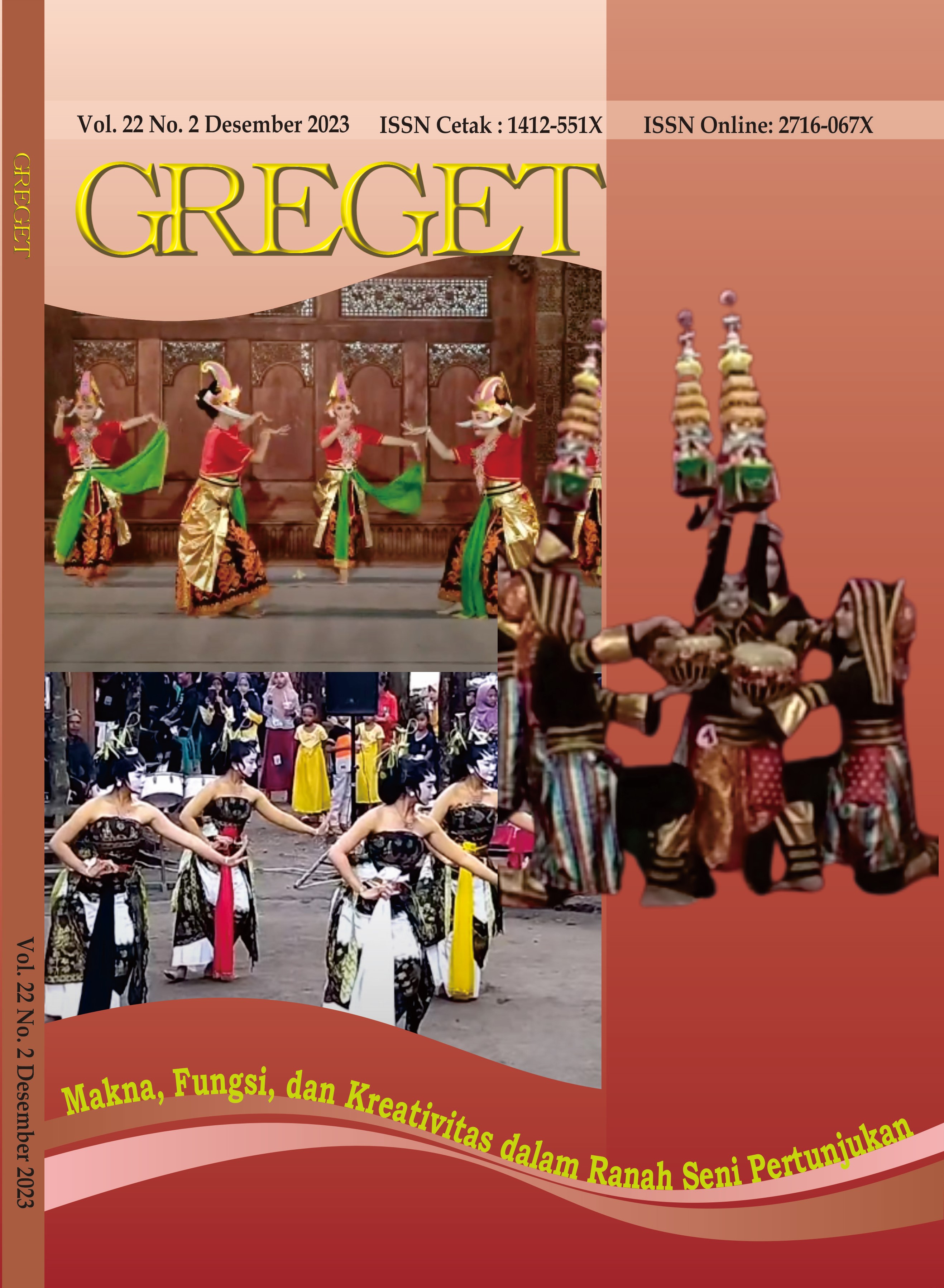PROSES PENCIPTAAN KARYA TARI UNBALANCED
Main Article Content
Abstract
Unbalanced is a dance work composed by Septiana Dewi in 2022 and performed at the Great Theater Building of the Indonesian Institute of the Arts in 2023. The Unbalanced dance work was inspired by the empirical experience of a deaf and mute person named Irfan Nurdiawan, a disabled athlete. Irfan Nurdiawan has had hearing loss since birth. However, Irfan tries to show others that he can also achieve like other normal children. The Unbalanced dance work is in the form of a group with five female dancers and Septiana Dewi as a dancer and choreographer. In the process, the dancers try to feel what kind of experience a deaf and mute person feels by covering their ears in a closed room and also in a crowded environment. This study is intended to describe the form of the Unbalanced dance work performance and the process of creating the Unbalanced dance work. The description of the form of the Unbalanced dance performance uses the theory of Slamet MD in his book entitled melihat Tari in 2016, and the process of creating the Unbalanced dance work uses the theory of Alma M. Hawkins quoted by Bambang Pudjasworo et al in the book Karya Cipta Seni Pertanggungaan in 2017. The method used in this study is qualitative research which includes observation, interviews and documentation. The results obtained in this study are in the form of a description of the form of performance consisting of movement, dancers, costume make-up, floor patterns, dance music and the place where the Unbalanced dance work is performed as well as the process of creating the Unbalanced dance work.
Downloads
Article Details

This work is licensed under a Creative Commons Attribution-ShareAlike 4.0 International License.
Copyright
Authors who publish with GREGET agrees to the following terms:
- Authors retain copyright and grant the journal right of first publication with the work simultaneously licensed under a Creative Commons Attribution-ShareAlike 4.0 (CC BY-SA 4.0) that allows others to share the work with an acknowledgment of the work's authorship and initial publication in this journal.
- Authors are able to enter into separate, additional contractual arrangements for the non-exclusive distribution of the journal's published version of the work (e.g., post it to an institutional repository or publish it in a book), with an acknowledgment of its initial publication in this journal.
- Authors are permitted and encouraged to post their work online (e.g., in institutional repositories or on their website) prior to and during the submission process, as it can lead to productive exchanges, as well as earlier and greater citation of published work.
References
Amelia, R. (2017). Koreografi Aku Pasti Bisa Karya Jonet Sri Kuncoro dalam Ketubuhan Kaum Difabel Tunarungu di SDLB dan SMPLB Bina Karya Inisiasi Cangkangan Karanganyar. Skripsi Prodi Seni Tari, Fakultas Seni Pertunjukan, Institut Seni Indonesia Surakarta.
Aryanti, A. V. (2022). Konstruksi Realitas Sosial dalam penciptaan Karya Waktu Ku Kecil, Tidak Besar. Skripsi Prodi Seni Tari, Fakultas Seni Pertunjukan, Institut Seni Indonesia Surakarta.
Bungin, B. (2007). Penelitian Kualitatif. Prenada Media Group.
Desiningrum, D. R. (2016). Psikologi Anak Berkebutuhan khusus. Psikosain.
Hadi, Y. S. (2003). Aspek Aspek Koreografi kelompok. LKPI.
Hawkins, A. M. (2003). Bergerak Menurut Kata Hati Metode baru dalam menciptakan Tari. Ford Foundation dan MSPI.
Maryono. (2011). Penelitian Kualitatif Seni Pertunjukan. ISI Press.
Maryono. (2015). Analisa Tari. ISI Press.
Mahendra, D. (2020). Penciptaan Tari Ins Spesial Bersama Anak Tunagrahita di SLB A YKAB Surakarta. Skripsi Prodi Seni Tari, Fakultas Seni Pertunjukan, Institut Seni Indonesia Surakarta.
Murgiyanto, S. (1993). Ketika Cahaya Merah Memudar – Sebuah Kritik Tari. Deviri Ganan Edition.
Nadjib, A. (2022). Ku Tubuh Ku. Skripsi Karya Seni, Prodi Seni Tari, Fakultas Seni Pertunjukan, Institut Seni Indonesia Surakarta.
Pudjasworo, B., dkk. (2017). Karya Cipta Seni Pertunjukan. Jb Publisher.
Slamet. (2016). Melihat Tari. Citra Sain.
Utari, R. (2017). Ekspresi Musdalifah Asrofi dan Niken Ayu Utami Siswa Tunarungu-wicara dalam Tari Merak. Tesis Pascasarjana, Institut Seni Indonesia Surakarta.
Widyastutieningrum, S. R., & Wahyudiarto, D. (2014). Pengantar Koreografi. ISI Press.
